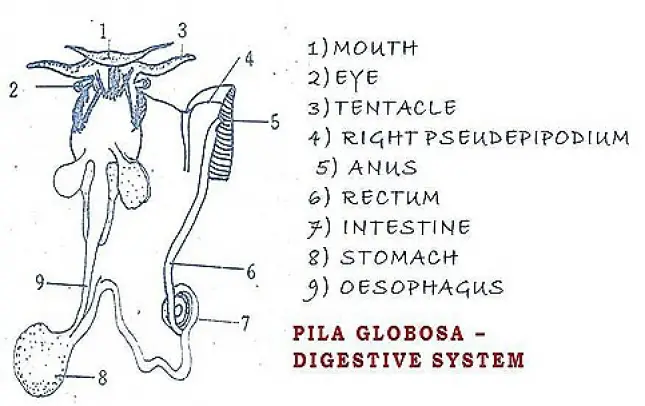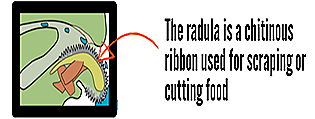Medically reviewed and approved by a board-certified member
Zoology
DIGESTIVE SYSTEM AND PROCESS OF DIGESTION IN PILA GLOBOSA (APPLE SNAIL)
By BS MediaTwitter Profile | Published: Saturday, 03 June 2017

In the digestive system of pila a long coiled alimentary canal and digestive glands are present. The alimentary canal will show the following parts.
1) Mouth: At the anterior end of the head mouth is present. It opens into buccal cavity.
2) Buccal cavity: Its walls are made by thick muscles. It shows jaws and radula On the floor of the buccal cavity odontophore is present. On this odontophore radula moves.
Radula is a long ribbon like structure. It shows transverse rows of teeth. Each row has 7 teeth. It works like a rasping organ. With the help of this organ pila will cut the food into bits.

3) Oesophagus: Buccal cavity opens into oesophagus. It is long tube. At the junction of oesophagus & buccal cavity two oesophageal cavities are present. They show salivary glands.
4) Stomach: Oesophagus opens into stomach. It is brown coloured sac like structure. It is divisible into two parts.
- Anterior part of the stomach is connected with oesophagus. Around this digestive glands are present.
- The posterior part of stomach is called pyloric stomach. It shows a blind caecum.
5) Intestine: Stomach leads into intestine. It is coiled. It leads into rectum.
6) Rectum: It travels parallel to epitaneal ridge and opens out through anus.
Digestive Glands :
- Buccal glands
- Salivary glands
- Digestive gland (or) Hepatopancreas.
- Buccal glands: In the buccal cavity wall these glands are present. They secrete a juice whose function is not clearly known.
- Salivary glands: They are present in the two oesophageal cavities. They give salivary ducts. They open into buccal cavity. The enzyme present in this saliva will digest the carbohydrates.
- Hepatopancreas: It is a big gland. It is brown in colour. It occupies bigger part of the visceral mass. In this gland three types of cells are present. They are
a) Secretory Cells: They secrete digestive juices.
b) Intracellular digesting Cells: These cells will perform intracellular digestion.
c) Calcium Cells: These cells will store calcium phosphate.
Digestion 1: Pila takes smaller plants and their leaves as food. With the help of walls of Buccal cavity it will catch the leaves. Radula will cut the leaves into bits. In the buccal cavity this food is mixed with saliva.
Digestion 2: The soft food will enter into stomach. The enzyme present in the saliva will digest the carbohydrates.
The digestive juices produced by the secretory cells of the hepatopancreas will digest the food in the stomach. Partly digested food particles will be taken by the cells of hapatopancreas and the digestion is completed in these cells. It is called intracellular digestion.
The undigested food will be sent out of the anus.
Tags:
End of the article